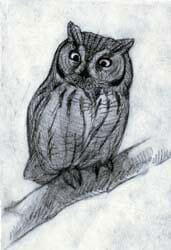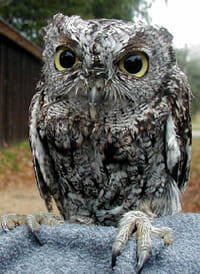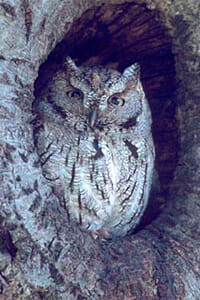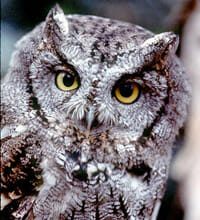Western Screech-Owl – Strigiformes Strigidae Ottus kennicutti
 |
 |
 |
 |
Identification & Description:
• Length: 8? inches Wingspan: 22? inches
• Small, nocturnal, predatory bird
• Large, rounded head with feathered ear tufts
• Yellow eyes
• Dense streaking on underparts with finer barring
• Dark gray or brown upperparts
• Gray or gray-brown with small black streaks on feathers.
• Sexes similar
• Size: 19-25 cm (7-10 in)
• Wingspan: 55-62 cm (22-24 in)
• Weight: 100-305 g (3.53-10.77 ounces)
Similar species:
The Western Screech-Owl is very similar in plumage to Whiskered and Eastern Screech-Owls and is best separated by voice. Other small owls lack prominent ear tufts.
Life History Groupings
• Migration Status: Permanent resident
• Breeding Habitat: Woodland
• Nest Type: Cavity
• Clutch Size: 4-5
• Length of Incubation: 21-30 days
• Days to Fledge: 28
• Number of Broods: 1?
• Diet:
Mostly: Small Mammals, Insects, Reptiles or Amphibians & Birds
Facts
• Occasionally takes prey larger than itself, including cottontail rabbits and Mallards.
• Western Screech-Owls are vulnerable to habitat loss because of urban development.
• Until recently it was considered the same species as the Eastern Screech-Owl.
Other Names
Petit-duc des montagnes (French)
Tecolote occidental (Spanish)
Owls make up the order Strigiformes. Typical owls make up the family Strigidae, and barn owls make up the family Tytonidae. The common barn owl is classified as Tyto alba, and the burrowing owl as Speotyto cunicularia. The largest genus of owls is Otus. The eastern screech owl is classified as Otus asio, and the Eurasian scops owl as Otus scops. Eagle owls make up the genus Bubo. The great horned owl is classified as Bubo virginianus, and the northern eagle owl as Bubo bubo. The elf owl is classified as Micrathene whitneyi.
Owl, common name for members of an order of nocturnal birds of prey. There are two families: the typical owls, with about 167 species; and the barn owls, with about 14 species. There are anatomical differences between the two families, but many generalizations apply to both.
The large eyes of owls (smaller in barn owls) are directed forward, and are encased in a capsule of bone called the sclerotic ring, which allows little eye movement. Owls must turn their entire heads to look sideways, facilitated by relatively long and flexible necks that permit the head to be rotated through 270 degrees. In most owls the eyes are surrounded by a facial disk of stiff feathers. As relatively few owls hunt their prey in full daylight, their hearing is particularly important. Many owls have asymmetrical skulls, with the ear openings at different levels; this enables the bird to get a “fix” on the sound made by a prey animal.
Owls range over the whole globe except in the Antarctic region; the common barn owl has one of the largest ranges among living birds. The nesting habits of owls are highly variable. Some nest in holes in trees or among rocks, others nest in large tree-nests, and others, such as burrowing owls, nest on the ground. All lay pure white eggs. Owls feed entirely on living animals, with the size of the prey proportional to the size of the owl, from insects to mammals as large as hares. A few feed primarily on fish. Indigestible portions of their food, such as bones, hair, and feathers, are compressed and regurgitated as compact pellets; analysis of pellet contents reveals their prey species.
Some genera of owls have many species; the largest genus contains more than 50 species. Some owls of this genus are well known, such as the eastern screech owl of eastern North America, and the Eurasian scops owl, a strongly migratory species breeding in southern Europe east to Lake Baikal. Many of the tropical species, however, are known from only a few museum specimens, and their habits have not been studied. All species belonging to the largest genus of owls look much alike, and, as might be expected in nocturnal birds, are differentiated most strongly by their distinctive voices.
Among the largest species of owls are the eagle owls. They have tufts of feathers on their heads that are called “ears” but are not related to true ears. Only the great horned owl is found in the Americas, but there are 17 species in Europe, Africa, and Asia. Most widely distributed is the northern eagle owl, found from Scandinavia and Spain to Japan. It is about 71 cm (28 in) long.
Smallest of the family is the elf owl of the southwestern United States and Mexico. It is 13 cm (5 in) long, and nests in woodpecker holes in large cacti.